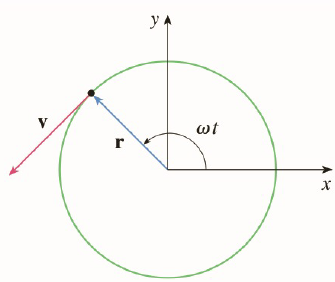
A particle P moves with constant angular speed
(a) Find the velocity vector v and show that
(b) Show that the speed
(c) Find the acceleration vector a. Show that it is proportional to r and that it points toward the origin. An acceleration with this property is called a centripetal acceleration. Show that the magnitude of the acceleration vector is
(d) Suppose that the particle has mass m. Show that the magnitude of the force F that is required to produce this motion, called a centripetal force, is

a)
To find:
The velocity vector
Answer to Problem 1P
Solution:
Explanation of Solution
1) Concept:
If
2) Given:
3) Calculation:
Consider
The velocity vector at time
Therefore, differentiating
Now
As
Since
Conclusion:
b)
To show:
The speed of particle
Answer to Problem 1P
Solution:
Explanation of Solution
1) Concept:
Speed of a particle is the magnitude of velocity vector
2) Given:
3) Calculation:
From part (a),
Therefore, as the speed of a particle is the magnitude of velocity vector
The period
At the speed
Therefore, period is
Conclusion:
The speed of particle
c)
To find:
Acceleration vector
Answer to Problem 1P
Solution:
Explanation of Solution
1) Concept:
The acceleration of a particle is
2) Calculation:
From part (a),
The acceleration of particle is
Therefore, differentiating
This concludes that acceleration is proportional to
The acceleration with this property is called centripetal acceleration.
Now, the magnitude of acceleration vector is given by
Conclusion:
The acceleration of particle is
Magnitude of acceleration vector is given by
d)
To show:
The magnitude of force required to produce this motion is
Answer to Problem 1P
Solution:
Explanation of Solution
1) Concept:
Here use Newton’s Second Law of motion.
Newton’s Second Law:
If at any time
2) Calculation:
By using Newton’s Second Law of motion,
Therefore, magnitude of force required to produce this motion is
From part (c),
Hence,
Conclusion:
The magnitude of force required to produce this motion is
Want to see more full solutions like this?
Chapter 13 Solutions
UD CALC (241 ONLY) W/1 TERM ACCESS >IB
- How does a fourier transform works?arrow_forwardDetermine the radius of convergence of a power series:12.6.5, 12.6.6, 12.6.7, 12.6.8Hint: Use Theorem12.5.1 and root test, ratio test, integral testarrow_forwardCan you answer this question and give step by step and why and how to get it. Can you write it (numerical method)arrow_forward
- Can you answer this question and give step by step and why and how to get it. Can you write it (numerical method)arrow_forwardThere are three options for investing $1150. The first earns 10% compounded annually, the second earns 10% compounded quarterly, and the third earns 10% compounded continuously. Find equations that model each investment growth and use a graphing utility to graph each model in the same viewing window over a 20-year period. Use the graph to determine which investment yields the highest return after 20 years. What are the differences in earnings among the three investment? STEP 1: The formula for compound interest is A = nt = P(1 + − − ) n², where n is the number of compoundings per year, t is the number of years, r is the interest rate, P is the principal, and A is the amount (balance) after t years. For continuous compounding, the formula reduces to A = Pert Find r and n for each model, and use these values to write A in terms of t for each case. Annual Model r=0.10 A = Y(t) = 1150 (1.10)* n = 1 Quarterly Model r = 0.10 n = 4 A = Q(t) = 1150(1.025) 4t Continuous Model r=0.10 A = C(t) =…arrow_forwardUse a graphing utility to find the point of intersection, if any, of the graphs of the functions. Round your result to three decimal places. (Enter NONE in any unused answer blanks.) y = 100e0.01x (x, y) = y = 11,250 ×arrow_forward
- 5. For the function y-x³-3x²-1, use derivatives to: (a) determine the intervals of increase and decrease. (b) determine the local (relative) maxima and minima. (e) determine the intervals of concavity. (d) determine the points of inflection. (e) sketch the graph with the above information indicated on the graph.arrow_forwardCan you solve this 2 question numerical methodarrow_forward1. Estimate the area under the graph of f(x)-25-x from x=0 to x=5 using 5 approximating rectangles Using: (A) right endpoints. (B) left endpoints.arrow_forward
- 9. Use fundamental theorem of calculus to find the derivative d a) *dt sin(x) b)(x)√1-2 dtarrow_forward3. Evaluate the definite integral: a) √66x²+8dx b) x dx c) f*(2e* - 2)dx d) √√9-x² e) (2-5x)dx f) cos(x)dx 8)²₁₂√4-x2 h) f7dx i) f² 6xdx j) ²₂(4x+3)dxarrow_forward2. Consider the integral √(2x+1)dx (a) Find the Riemann sum for this integral using right endpoints and n-4. (b) Find the Riemann sum for this same integral, using left endpoints and n=4arrow_forward
 Trigonometry (MindTap Course List)TrigonometryISBN:9781305652224Author:Charles P. McKeague, Mark D. TurnerPublisher:Cengage LearningAlgebra & Trigonometry with Analytic GeometryAlgebraISBN:9781133382119Author:SwokowskiPublisher:Cengage
Trigonometry (MindTap Course List)TrigonometryISBN:9781305652224Author:Charles P. McKeague, Mark D. TurnerPublisher:Cengage LearningAlgebra & Trigonometry with Analytic GeometryAlgebraISBN:9781133382119Author:SwokowskiPublisher:Cengage Trigonometry (MindTap Course List)TrigonometryISBN:9781337278461Author:Ron LarsonPublisher:Cengage Learning
Trigonometry (MindTap Course List)TrigonometryISBN:9781337278461Author:Ron LarsonPublisher:Cengage Learning


